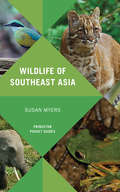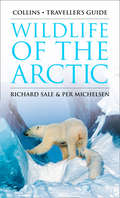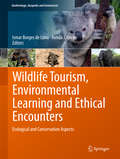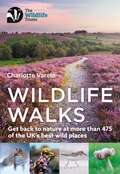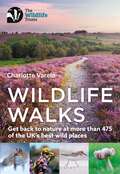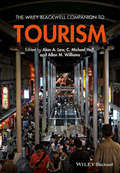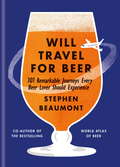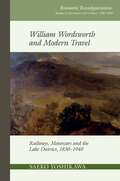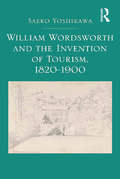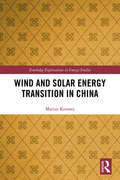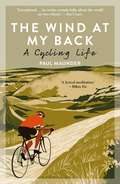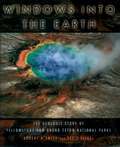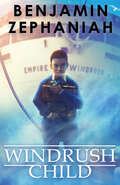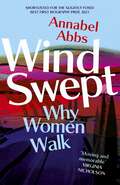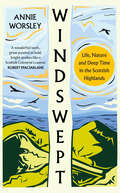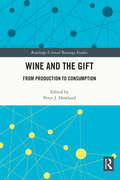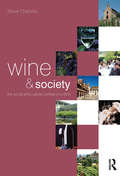- Table View
- List View
Wildlife of Southeast Asia
by Susan MyersThis handy photographic guide offers a stunning look at the wildlife of Southeast Asia, which includes Burma, Thailand, Laos, Cambodia, Vietnam, West Malaysia, and Singapore. Accessible text and more than 500 color photographs help readers to learn about and identify the most common species found in the region, particularly the mammals, birds, reptiles, amphibians, and insects that visitors will most likely encounter. Detailed photos are accompanied on facing pages by succinct species accounts highlighting key identification features, status, and distribution. The book's brief introduction offers readers useful information on major wildlife sites as well as practical advice on making the most of a wildlife-watching trip.Wildlife of Southeast Asia is the essential resource for visitors and residents interested in the fauna of this fascinating area of the world.A photographic guide to the wildlife of Southeast Asia, including Burma, Thailand, Laos, Cambodia, Vietnam, West Malaysia, and SingaporeMore than 500 stunning color photographsAccessible species accounts highlight key identification features, status, and distributionA brief introduction discusses wildlife locations and practical travel know-how
Wildlife of the Arctic (Traveller’s Guide)
by Richard SaleThis book celebrates the Arctic, exploring the natural history that has so inspired generations.
Wildlife Tourism, Environmental Learning and Ethical Encounters: Ecological and Conservation Aspects (Geoheritage, Geoparks and Geotourism)
by Ismar Borges de Lima Ronda J. GreenThis book outlines the status quo of worldwide wildlife tourism and its impacts on planning, management, knowledge, awareness, behaviour and attitudes related to wildlife encounters. It sets out to fill the considerable gaps in our knowledge on wildlife tourism, applied ecology, and environmental education, providing comprehensive information on and an interdisciplinary approach to effective management in wildlife tourism. Examining the intricacies, challenges, and lessons learned in a meaningful and rewarding tourism niche, this interdisciplinary book comprehensively examines the major potentials and controversies in the wildlife tourism industry. Pursuing an insightful, provocative and hands-on approach, it primarily addresses two questions: ‘Can we reconcile the needs of the wildlife tourism industry, biodiversity conservation, ecological learning and animal ethics issues?’ and ‘What is the Future of the Wildlife Tourism Industry?’. Though primarily intended as a research text, it also offers a valuable resource for a broad readership, which includes university and training students, researchers, scholars, tourism practitioners and professionals, planners and managers, as well as the staff of government agencies.
Wildlife Walks: Get back to nature at more than 475 of the UK's best wild places
by Charlotte VarelaThe definitive guide to Britain's stunning wildlife heritage, showcasing more than 475 walks through the Wildlife Trust's forest, heaths, moors and woods. Published in conjunction with the Wildlife Trusts, Wildlife Walks is a superb guide to more than 475 of the UK's top nature reserves, all of them owned and managed by the unique network of Wildlife Trusts.Organised by region, each entry includes information on access and conditions, opening times, facilities, how to get there, and local attractions. Boxes highlighting special species of interest are dotted throughout the book. Illustrated throughout with many beautiful colour photographs and maps, Wildlife Walks is the only guide you'll need to plan a great family day out.
Wildlife Walks: Get back to nature at more than 475 of the UK's best wild places
by Charlotte VarelaThe definitive guide to Britain's stunning wildlife heritage, showcasing more than 475 walks through the Wildlife Trust's forest, heaths, moors and woods. Published in conjunction with the Wildlife Trusts, Wildlife Walks is a superb guide to more than 475 of the UK's top nature reserves, all of them owned and managed by the unique network of Wildlife Trusts.Organised by region, each entry includes information on access and conditions, opening times, facilities, how to get there, and local attractions. Boxes highlighting special species of interest are dotted throughout the book. Illustrated throughout with many beautiful colour photographs and maps, Wildlife Walks is the only guide you'll need to plan a great family day out.
The Wiley Blackwell Companion to Tourism (Wiley Blackwell Companions to Geography)
by C. Michael Hall Allan M. Williams Alan A. LewThe Wiley Blackwell Companion to Tourism presents a collection of readings that represent an essential and authoritative reference on the state-of-the-art of the interdisciplinary field of tourism studies. Presents a comprehensive and critical overview of tourism studies across the social sciences Introduces emerging topics and reassesses key themes in tourism studies in the light of recent developments Includes 50 newly commissioned essays by leading experts in the social sciences from around the world Contains cutting-edge perspectives on topics that include tourism’s role in globalization, sustainable tourism, and the state’s role in tourism development Sets an agenda for future tourism research and includes a wealth of bibliographic references
The Wiley Blackwell Companion to Tourism (Wiley Blackwell Companions to Geography)
by Alan A. Lew C. Michael Hall Allan M. WilliamsThe Wiley Blackwell Companion to Tourism presents a collection of readings that represent an essential and authoritative reference on the state-of-the-art of the interdisciplinary field of tourism studies. Presents a comprehensive and critical overview of tourism studies across the social sciences Introduces emerging topics and reassesses key themes in tourism studies in the light of recent developments Includes 50 newly commissioned essays by leading experts in the social sciences from around the world Contains cutting-edge perspectives on topics that include tourism’s role in globalization, sustainable tourism, and the state’s role in tourism development Sets an agenda for future tourism research and includes a wealth of bibliographic references
Will Storr Vs. The Supernatural: One man's search for the truth about ghosts
by Will StorrWhen journalist and ghost sceptic Will Storr heads to Philadelphia to meet Lou Gentile, a demonologist, he expects a little fun with an amusing eccentric. What he gets are terrifying experiences of spectral lights and horrific demonic growling - and all of his safe, adult preconceptions about ghosts instantly vanish.In the cold light of day, Will decides on a quest for the truth about ghosts. He meets professional paranormal investigators and takes part in séances and a vigil in the most haunted house in Britain, tries out divining rods and ouija boards, and goes on set with TV's Most Haunted. But Will also seeks out the sceptics in clinical psychology and philosophy who ask if spirits are really just in our heads.His journey is full of bizarre, terrifying and hilarious experiences, each one a new insight into life, death and what might come after.
Will Travel For Beer: 101 Remarkable Journeys Every Beer Lover Should Experience
by Stephen BeaumontFrom the walkable breweries of Ashville, North Carolina, to the Ølfestival in Copenhagen, Oktoberfest in Brazil to the breweries of Beijing, discover 101 traditional, quirky, absurd, must-visit beer destinations across the globe. Find the world's most romantic pub crawl in Bruges, drink beer in paradise in Latin America or step into Germany via Bangkok, Thailand. Complete with tasting notes, drinking tips and handy address lists, this is the perfect gift for both beer enthusiasts and keen travellers alike.
William Wordsworth and Modern Travel: Railways, Motorcars and the Lake District, 1830-1940 (Romantic Reconfigurations: Studies in Literature and Culture 1780-1850 #12)
by Saeko YoshikawaThis book explores Wordsworth’s extraordinary influence on the tourist landscapes of the Lake District throughout the age of railways, motorcars and the First World War. It reveals how Wordsworth’s response to railways was not a straightforward matter of opposition and protest; his ideas were taken up by both advocates and opponents of railways, and through their controversies had a surprising impact on the earliest motorists as they sought a language to describe the liberty and independence of their new mode of transport. Once the age of motoring was underway, the outbreak of the First World War encouraged British people to connect Wordsworth’s patriotic passion with his wish to protect the Lake District as a national heritage – a transition that would have momentous effects in the interwar period, when popular motoring paradoxically brought a vogue for open-air activities and a renewal of romantic pedestrianism. With the arrival of global tourism, preservation of the cultural landscape of the Lake District became an urgent national and international concern. This book explores how patterns of tourist behaviour and environmental awareness changed in the century of popular tourism, examining how Wordsworth’s vision and language shaped modern ideas of travel, self-reliance, landscape and environment, cultural heritage, preservation and accessibility.
William Wordsworth and the Invention of Tourism, 1820-1900
by Saeko YoshikawaIn her study of the opening of the English Lake District to mass tourism, Saeko Yoshikawa examines William Wordsworth’s role in the rise and development of the region as a popular destination. For the middle classes on holiday, guidebooks not only offered practical information, but they also provided a fresh motive and a new model of appreciation by associating writers with places. The nineteenth century saw the invention of Robert Burns’s and Walter Scott’s Borders, Shakespeare’s Stratford, and the Brontë Country as holiday locales for the middle classes. Investigating the international cult of Wordsworthian tourism, Yoshikawa shows both how Wordsworth’s public celebrity was constructed through the tourist industry and how the cultural identity of the Lake District was influenced by the poet’s presence and works. Informed by extensive archival work, her book provides an original case study of the contributions of Romantic writers to the invention of middle-class tourism and the part guidebooks played in promoting the popular reputations of authors.
William Wordsworth and the Invention of Tourism, 1820-1900
by Saeko YoshikawaIn her study of the opening of the English Lake District to mass tourism, Saeko Yoshikawa examines William Wordsworth’s role in the rise and development of the region as a popular destination. For the middle classes on holiday, guidebooks not only offered practical information, but they also provided a fresh motive and a new model of appreciation by associating writers with places. The nineteenth century saw the invention of Robert Burns’s and Walter Scott’s Borders, Shakespeare’s Stratford, and the Brontë Country as holiday locales for the middle classes. Investigating the international cult of Wordsworthian tourism, Yoshikawa shows both how Wordsworth’s public celebrity was constructed through the tourist industry and how the cultural identity of the Lake District was influenced by the poet’s presence and works. Informed by extensive archival work, her book provides an original case study of the contributions of Romantic writers to the invention of middle-class tourism and the part guidebooks played in promoting the popular reputations of authors.
Willoughbyland: England's Lost Colony
by Matthew ParkerAt the beginning of the 1650s, England was in ruins – wrecked, impoverished, grief-stricken by plague and civil war. Yet shimmering on the horizon was an intoxicating possibility, a vision of paradise: Willoughbyland.Ambitious and free-thinking adventurers poured in, attracted by the toleration, the optimism, the rich soil and the promise of the gold of El Dorado. It was England's most hopeful colony. But the Restoration saw the end of political freedom, and brought in its place spies, war, rebellion and treachery. The advent of racial slavery poisoned everything. What started out as a heaven was soon to become one of the cruellest places on earth.The history of Willoughbyland is a microcosm of empire, its heady attractions and fatal dangers.
Wind and Solar Energy Transition in China (Routledge Explorations in Energy Studies)
by Marius KorsnesThis book explores the mobilisation of China’s wind and solar industries and examines the implications of this development to energy generation and distribution, innovation and governance. Unlike other publications that focus mainly on the formal policy landscape and statistics of industry development, this book delves deeper into the ways in which the wind and solar industries have evolved through negotiations made by the involved stakeholders, and how these industries play into larger Chinese development and policymaking interests. Overall, it sheds new light on the strategic development of China’s renewable energy industry, the flexible governance methods employed and the internal struggles which Chinese local, regional and central policymakers, and state-owned and private enterprises have faced. This book will be of great relevance to students and scholars of renewable energy technologies, energy policy and sustainability transitions, as well as policymakers with a specific interest in China.
Wind and Solar Energy Transition in China (Routledge Explorations in Energy Studies)
by Marius KorsnesThis book explores the mobilisation of China’s wind and solar industries and examines the implications of this development to energy generation and distribution, innovation and governance. Unlike other publications that focus mainly on the formal policy landscape and statistics of industry development, this book delves deeper into the ways in which the wind and solar industries have evolved through negotiations made by the involved stakeholders, and how these industries play into larger Chinese development and policymaking interests. Overall, it sheds new light on the strategic development of China’s renewable energy industry, the flexible governance methods employed and the internal struggles which Chinese local, regional and central policymakers, and state-owned and private enterprises have faced. This book will be of great relevance to students and scholars of renewable energy technologies, energy policy and sustainability transitions, as well as policymakers with a specific interest in China.
The Wind At My Back: A Cycling Life
by Mr Paul MaunderA lone cyclist, disappearing into a wild landscape – brave, free, engaged with the world. It's the kind of image that sells bikes, magazines, clothing; a romantic image that all cyclists aspire to. For cycling is an activity deeply and intimately involved with landscape. The bicycle allows us to explore, to engage with wild places, and return in time for dinner. It also allows us to investigate our surroundings closer to home. It is an activity which, for most of us, happens at a speed that allows a great deal of voyeurism. We peer into houses and shops, gardens and farmyards, fields and hedgerows. What we see may be familiar or alien, but for the creative mind it is always stimulating. Yet – unlike with walking or swimming – the connection between cycling and creativity has only been explored in fragments.On a bicycle, as one is exposed to sights – new or otherwise, through chance or purposeful searching – the repetitive physical actions of cycling work on the mind in a different way to those of walking. The shape of a long ride can become the shape of a novel; the atmosphere imbued by the weather, the hills, the physical exertion, can all influence a writer's tone. Our memories have a dialogue with the landscape; we remember rides through the landscape, and the landscape shapes our thinking. And for Paul Maunder – a writer all his adult life – cycling and creativity have always been interlinked. In The Wind on Your Back, Maunder takes a journey from the most dense centres of population to the wild places; starting from cycling in a major city, then moving through suburbia, the edgelands at the periphery of the city, then into the managed and pastoral farmland, and beyond to the sublime mountains.He explores the experience and history of cycling in these different types of place, and seeks to understand how cycling has played a role in his own creative life as well as that of other cyclist-artists, musicians, photographers, writers and painters. Played out against the backdrop of the British countryside, and drawing of elements of psychogeography and human geography, Maunder seeks to understand the way the outside world interacts with the creative mind, and the way our surroundings help to shape who we are.
The Wind In My Wheels: Travel Tales from the Saddle
by Josie DewAs a young girl, Josie Dew developed an overpowering urge to travel. She also fell out of a fast-moving vehicle and, rather inconveniently, developed a lifelong aversion to cars. Along came her first bicycle, and she has never looked back. Four continents, thirty-six countries and eighty thousand miles worth of astounding adventures, eccentric characters, varied cultures and ever-enduring optimism are the result of her travels.From Saharan locust invasions to tree-climbing goats, and a customs official who wouldn't let her leave India because 'You are making me a very fine wife', her encounters are described with honesty, wit and perception. Strange incidents and bizarre circumstances punctuate her journeys: in Nepal she met a team of Frenchmen running from Paris to China, and a cyclist on his way from one Olympic Games to the next. In Udaipur she was greeted by everyone with the refrain 'Hello Mr. Jamie Bond Octopussy filmed here', whilst her view of post-Ceausescu Romania, a nation suffering and starving, affected her both physically and mentally.THE WIND IN MY WHEELS is informative, illuminating, and ceaselessly amusing.
Windows into the Earth: The Geologic Story of Yellowstone and Grand Teton National Parks
by Robert B. Smith Lee J. SiegelMillions of years ago, the North American continent was dragged over the world's largest continental hotspot, a huge column of hot and molten rock rising from the Earth's interior that traced a 50-mile wide, 500-mile-long path northeastward across Idaho. Generating cataclysmic volcanic eruptions and large earthquakes, the hotspot helped lift the Yellowstone Plateau to more than 7,000 feet and pushed the northern Rockies to new heights, forming unusually large glaciers to carve the landscape. It also created the jewel of the U.S. national park system: Yellowstone. Meanwhile, forces stretching apart the western U.S. created the mountainous glory of Grand Teton National Park. These two parks, with their majestic mountains, dazzling geysers, and picturesque hot springs, are windows into the Earth's interior, revealing the violent power of the dynamic processes within. Smith and Siegel offer expert guidance through this awe-inspiring terrain, bringing to life the grandeur of these geologic phenomena as they reveal the forces that have shaped--and continue to shape--the greater Yellowstone-Teton region. Over seventy illustrations--including fifty-two in full color--illuminate the breathtaking beauty of the landscape, while two final chapters provide driving tours of the parks to help visitors enjoy and understand the regions wonders. Fascinating and informative, this book affords us a striking new perspective on Earth's creative forces.
Windows into the Earth: The Geologic Story of Yellowstone and Grand Teton National Parks
by Robert B. Smith Lee J. SiegelMillions of years ago, the North American continent was dragged over the world's largest continental hotspot, a huge column of hot and molten rock rising from the Earth's interior that traced a 50-mile wide, 500-mile-long path northeastward across Idaho. Generating cataclysmic volcanic eruptions and large earthquakes, the hotspot helped lift the Yellowstone Plateau to more than 7,000 feet and pushed the northern Rockies to new heights, forming unusually large glaciers to carve the landscape. It also created the jewel of the U.S. national park system: Yellowstone. Meanwhile, forces stretching apart the western U.S. created the mountainous glory of Grand Teton National Park. These two parks, with their majestic mountains, dazzling geysers, and picturesque hot springs, are windows into the Earth's interior, revealing the violent power of the dynamic processes within. Smith and Siegel offer expert guidance through this awe-inspiring terrain, bringing to life the grandeur of these geologic phenomena as they reveal the forces that have shaped--and continue to shape--the greater Yellowstone-Teton region. Over seventy illustrations--including fifty-two in full color--illuminate the breathtaking beauty of the landscape, while two final chapters provide driving tours of the parks to help visitors enjoy and understand the regions wonders. Fascinating and informative, this book affords us a striking new perspective on Earth's creative forces.
Windswept: walking in the footsteps of remarkable women
by Annabel Abbs'A triumph ... I felt as though I were being lifted, carried up to peaks.' - Charlotte Peacock, author of. Into the Mountain: A Life of Nan Shepherd 'I couldn't put it down. Quite extraordinary... written in such a free flowing, readable style. I'm in awe.' - Maggie Humm, author of Talland HouseThe story of extraordinary women who lost their way - their sense of self, their identity, their freedom - and found it again through walking in the wild. A feminist exploration of the power of walking in nature, following in the footsteps of Gwen John, Georgia O'Keeffe, Frieda Lawrence, Clara Vyvyan, Simone de Beauvoir, Daphne Du Maurier and Nan Shepherd. For centuries, the wilds have been male territory, while women sat safely confined at home. But not all women did as they were told, despite the dangers; history is littered with women for whom rural walking became inspiration, consolation and liberation. In this powerful and deeply inspiring book, Annabel Abbs uncovers women who refused to conform, who recognised a biological, emotional and artistic need for wilderness, water and desert - and who took the courageous step of walking unpeopled and often forbidding landscapes. Part wild-walk, part memoir, Windswept follows an exhilarating journey from Abbs' isolated car-less childhood to her walking the remote paths trodden by extraordinary women including Georgia O'Keeffe in the empty plains of Texas and New Mexico, Nan Shepherd in the mountains of Scotland, Gwen John following the Garonne, Simone de Beauvoir in the mountains and forests of France and Daphne du Maurier following the River Rhone. A single question pulses through their walks: How does a woman change once she becomes windswept?
Windswept: Life, Nature And Deep Time In The Scottish Highlands
by Annie Worsley‘Windswept is a wonderful work, prose painted in bold, bright strokes like a Scottish Colourist's canvas’ ROBERT MACFARLANE ‘I have read pages and pages of this wonderful book, swept away by its beauty and understanding, its chromatic brilliance’ ADAM NICOLSON
Wine and The Gift: From Production to Consumption (Routledge Critical Beverage Studies)
by Peter J. HowlandWine as commodity has received enormous academic attention, while wine as gift has largely eluded significant dedicated research and analysis. This book addresses this lacuna with insights from leading scholars from a range of disciplines exploring wine as gift in different moments of history, across a variety of production to consumption contexts, and across societies and cultures. The book draws on examples from Australia, China, Croatia, France, Italy, Moldova, United Kingdom and Aotearoa New Zealand. Through the analysis of wine as gift, indeed often as a commodity-gift hybrid, this book significantly enhances understandings of the intertwined economic, societal, political and moral aspects of wine and its production, exchange, and consumption. Wine and the Gift: From Production to Consumption will appeal to researchers and undergraduates from a wide range of disciplines, including sociology, history, anthropology, cultural studies, geography, marketing, and business studies.
Wine and The Gift: From Production to Consumption (Routledge Critical Beverage Studies)
by Peter J. HowlandWine as commodity has received enormous academic attention, while wine as gift has largely eluded significant dedicated research and analysis. This book addresses this lacuna with insights from leading scholars from a range of disciplines exploring wine as gift in different moments of history, across a variety of production to consumption contexts, and across societies and cultures. The book draws on examples from Australia, China, Croatia, France, Italy, Moldova, United Kingdom and Aotearoa New Zealand. Through the analysis of wine as gift, indeed often as a commodity-gift hybrid, this book significantly enhances understandings of the intertwined economic, societal, political and moral aspects of wine and its production, exchange, and consumption. Wine and the Gift: From Production to Consumption will appeal to researchers and undergraduates from a wide range of disciplines, including sociology, history, anthropology, cultural studies, geography, marketing, and business studies.
Wine and Society
by Steve ChartersWine is becoming increasingly popular in the Anglophone world and there are many books available which describe how and where it is made. However, none address the fundamental questions of different structures of production and how the consumer relates to the product – this book is the first to do just that.Wine and Society: the cultural and social context of wine production and consumption looks at the relationship between wine production and marketing, focussing in consumer behaviour and cultural attitudes. Divided into four parts, it examines the context of wine production, the wine consumer and the social context of wine, discussing the following themes:* That the core of wine production and consumption is shaped by historical, geographical and cultural factors.* Wine production – European and new world looking at the different kinds of producer and how the varying background of each shapes their perspective on what they produce* Terroir and appellations: why demarcation and sense of place became important, how they are used to achieve marketing differentiation, and the 'benefits’ (or otherwise) to the customer.* The contemporary wine consumer and lifestyle factors – looking at wine clubs, tourism, education, culture and literature* The politics and economics of wine – from supporting rural industries in France to protecting customers from deception and health risks.Suitable for third year and post-graduate students of hospitality, wine (both in production and marketing), wine tourism, gastronomy and related courses, it encourages students to think critically about the issues raised by using real life case studies and examples from around the world, also including press releases and marketing campaigns.
